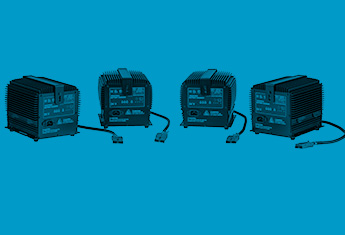Your shopping cart is empty.
How to Charge Your Lead Acid Batteries
Posted in Best Practices,
A lot has changed in 160 years, which is when lead acid batteries were invented. Lead acid batteries are the most common battery type and are low maintenance, 100% recyclable, and may offer the most bang for your buck in terms of price.
Types of Lead Acid Batteries
WET BATTERY
Wet (Flooded) Lead Acid Batteries
- Best for applications where long runtime is needed
- Designed to deliver consistent and reliable power
- Require regular battery watering
- Lowest cost lead acid battery ($)

Wet (Flooded) Lead Acid Battery

Sealed Lead Acid Battery
SEALED BATTERIES
AGM (Absorbent Glass Mat) Lead Acid Batteries
- Best for applications where short runtime is needed
- Eliminate the need for battery watering
- Eliminate risk of acid contact
- Short battery life
- Moderate cost lead acid battery ($$)
Gel Lead Acid Batteries
- Best for applications where short runtime is needed
- Eliminate the need for battery watering
- Typically higher cost than standard ($$$)
- Medium battery life
- Eliminate risk of acid contact
- Longer cycle life over standard AGM
TPPL (Thin Plate Pure Lead) Batteries:
- A type of AGM battery that can be opportunity charged
- Eliminate need for battery watering
- Fastest recharge
- Longer cycle life than standard AGM or GEL
- Most expensive type of lead acid battery ($$$$)
Tips for Charging Lead Acid Batteries
Battery watering is one part of lead acid battery maintenance. Proper charging practices are just as critical to optimizing run time and increasing the number of charge cycles in the life of the battery. Here’s what you need to know:
- Monitor the water levels: Do not let the water level fall below plates.
- Use the correct water type: When topping off your battery’s fill well, always use distilled or de-ionized water. Tap water typically contains minerals that can damage lead acid batteries and/or impact performance and lifespan.
- Start the day fully charged: Lead acid batteries should be charged every day after 15 minutes or more of use. Before using the following day, the machine must be plugged in and charged until the charger indicates the batteries are FULLY charged. Failure to allow the batteries to fully charge before the next use will diminish the life of the batteries.
- One full charge per day: Do not fully charge lead acid batteries more than once per 24-hour period to maximize your battery’s life. Opportunity charging, which means plugging in the machine for a short period of time without fully charging, can negatively impact the life of the batteries. (Not applicable to TPPL batteries.)
- Fully charge batteries before storing: Lead acid batteries should never be stored in a discharged state. Some of today’s machines place parasitic loads on the batteries. Even when the machine’s key is in the “OFF” position, there are electrical components drawing upon the battery’s energy.
- Check fluid levels: The flooded (wet) lead-acid batteries require routine watering (unless equipped with Smart- Fill™ Automatic Battery Watering technology). Check the battery electrolyte level weekly. The electrolyte level should be slightly above the battery plates as shown before charging. Add distilled water if low. Do not overfill. The electrolyte will expand and may overflow when charging. After charging, distilled water can be added up to about 3 mm (0.12 in) below the sight tubes.
- Use the correct charger: The battery charger is set to charge the battery type supplied with your machine. If you choose to change to a different battery type or capacity, the charger’s charging profile must be changed to prevent battery damage.
- Seek out new charger technology: Older lead acid battery chargers require careful monitoring to avoid “over-charging.” But new charger technology allows the batteries and charger to be plugged in over a weekend or longer. The charger will shut off once the full charge on batteries is reached. Some newer chargers can monitor the batteries and turn them back on as the batteries require a charge.
- Ideal charging conditions: Charge the batteries in a well-ventilated area of no more than 80 degrees Fahrenheit to prevent possible gas buildup. Never store or charge batteries in a place that is exposed to freezing temperatures, direct sunlight or heat, or other temperature extremes.
- Follow your operator manual: All of these battery charging best practices are fairly universal for all types of lead acid batteries. But, of course, be sure to read the operator manual for your Tennant cleaning machine for the specific charging protocols.
For the performance and price, lead acid batteries can deliver a great value, but require the use of proper charging practices. By following these simple steps for proper charging, you can make sure you’re fully realizing this value, getting the most run time and charge cycles out of your battery, and maximizing the performance of your Tennant cleaning machine.

Follow this daily use/charge cycle to maintain the performance of your lead acid batteries.

Checking fluid levels at least weekly ensures there is enough distilled water to cover the lead plates.
RELATED LINKS
Ready to take your cleaning to the next level?
Whether you are requesting a product demonstration or a quote, ordering parts, or making a service appointment, you've come to the right place. Tennant professional representatives are ready with answers to your questions, and we look forward to showing you how much we appreciate your business.




